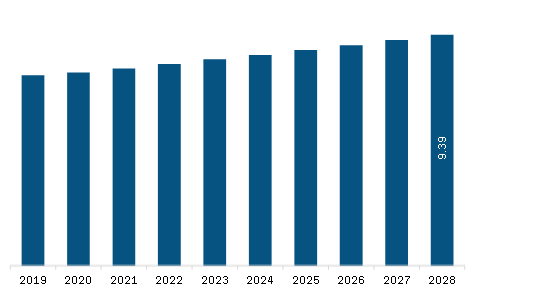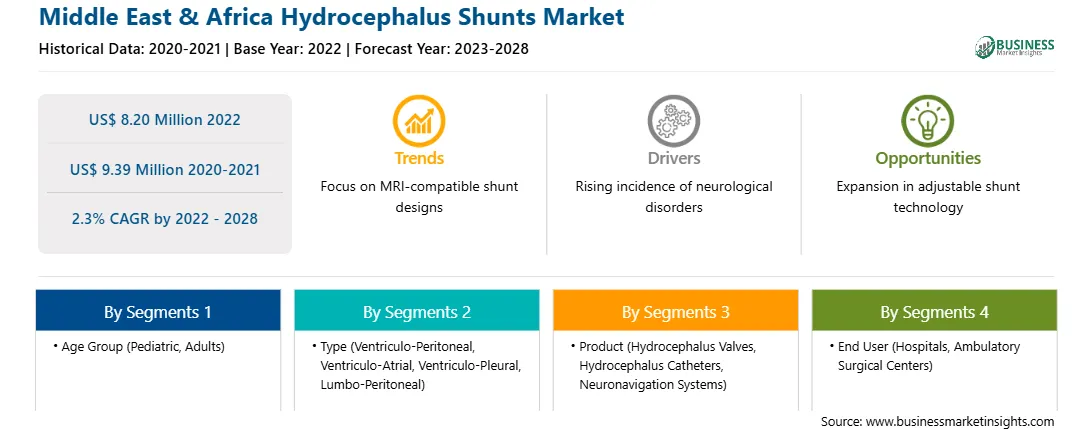Cerebrospinal fluid (CSF) in the brain and spinal cord protects the central nervous system from injury and infection. The accumulation of excess CSF in brain cavities adds to intracranial pressure, thereby leading to hydrocephalus. The condition may further lead to macrocephaly and cognitive dysfunctions. The treatment approach of hydrocephalus highly focuses on managing CSF through medical devices named shunts. The shunt systems remove excess CSF from the brain and divert it to other body parts, wherein it is absorbed as a part of the circulatory process. Thus, the high incidence of hydrocephalus drives the demand for hydrocephalus shunts, thereby boosting the Middle East & Africa hydrocephalus shunts market growth.
The Middle East & Africa hydrocephalus shunts market is segmented into Saudi Arabia, the UAE, South Africa, and the Rest of MEA. The market growth in this region is ascribed to the increasing prevalence of neurological conditions, a rise in the geriatric population, and a surge in novel technological advancements. For instance, according to studies, the prevalence of neurodegenerative diseases in Arab countries ranges from 1.1% to 2.3% among people with age ≥50 and 13.5% to 18.5% among people with age ≥80. However, the lack of access to modern medical devices, such as hydrocephalus shunts, in low and middle-income countries may restrain the market growth.

Strategic insights for the Middle East & Africa Hydrocephalus Shunts provides data-driven analysis of the industry landscape, including current trends, key players, and regional nuances. These insights offer actionable recommendations, enabling readers to differentiate themselves from competitors by identifying untapped segments or developing unique value propositions. Leveraging data analytics, these insights help industry players anticipate the market shifts, whether investors, manufacturers, or other stakeholders. A future-oriented perspective is essential, helping stakeholders anticipate market shifts and position themselves for long-term success in this dynamic region. Ultimately, effective strategic insights empower readers to make informed decisions that drive profitability and achieve their business objectives within the market.

| Report Attribute | Details |
|---|---|
| Market size in 2022 | US$ 8.20 Million |
| Market Size by 2028 | US$ 9.39 Million |
| Global CAGR (2022 - 2028) | 2.3% |
| Historical Data | 2020-2021 |
| Forecast period | 2023-2028 |
| Segments Covered |
By Age Group
|
| Regions and Countries Covered | Middle East and Africa
|
| Market leaders and key company profiles |
The geographic scope of the Middle East & Africa Hydrocephalus Shunts refers to the specific areas in which a business operates and competes. Understanding local distinctions, such as diverse consumer preferences (e.g., demand for specific plug types or battery backup durations), varying economic conditions, and regulatory environments, is crucial for tailoring strategies to specific markets. Businesses can expand their reach by identifying underserved areas or adapting their offerings to meet local demands. A clear market focus allows for more effective resource allocation, targeted marketing campaigns, and better positioning against local competitors, ultimately driving growth in those targeted areas.

The Middle East & Africa hydrocephalus shunts market is segmented into by age group, type, product, end user, and country.
Based on age group, the Middle East & Africa hydrocephalus shunts market is segmented into pediatric, and adults. The pediatric segment held the larger market share in 2022.
Based on type, the Middle East & Africa hydrocephalus shunts market is segmented into ventriculo-peritoneal, ventriculo-atrial, ventriculo-pleural, and lumbo-peritonea. The ventriculo-peritoneal segment held the largest market share in 2022.
Based on product, the Middle East & Africa hydrocephalus shunts market is segmented into hydrocephalus valves, hydrocephalus catheters, neuronavigation systems, and others. The hydrocephalus valves segment dominated the market share in 2022.
Based on end user, the Middle East & Africa hydrocephalus shunts market is segmented into hospitals, ambulatory surgical centers, others. The hospital segment dominated the market share in 2022.
Based on country, the Middle East & Africa hydrocephalus shunts market is segmented into South Africa, Saudi Arabia, the UAE, and the Rest of Middle East and Africa. The South Africa segment dominated the market share in 2022.
B. Braun Melsungen AG (CHRISTOPH MIETHKE GMBH & CO. KG); Integra LifeSciences Holdings Corporation, HpBio Próteses, inc.; Medtronic; Natus Medical Incorporated; Spiegelberg GmbH & Co. KG.; and Desu Medical are the leading companies operating in the Middle East & Africa hydrocephalus shunts market.
The Middle East & Africa Hydrocephalus Shunts Market is valued at US$ 8.20 Million in 2022, it is projected to reach US$ 9.39 Million by 2028.
As per our report Middle East & Africa Hydrocephalus Shunts Market, the market size is valued at US$ 8.20 Million in 2022, projecting it to reach US$ 9.39 Million by 2028. This translates to a CAGR of approximately 2.3% during the forecast period.
The Middle East & Africa Hydrocephalus Shunts Market report typically cover these key segments-
The historic period, base year, and forecast period can vary slightly depending on the specific market research report. However, for the Middle East & Africa Hydrocephalus Shunts Market report:
The Middle East & Africa Hydrocephalus Shunts Market is populated by several key players, each contributing to its growth and innovation. Some of the major players include:
The Middle East & Africa Hydrocephalus Shunts Market report is valuable for diverse stakeholders, including:
Essentially, anyone involved in or considering involvement in the Middle East & Africa Hydrocephalus Shunts Market value chain can benefit from the information contained in a comprehensive market report.